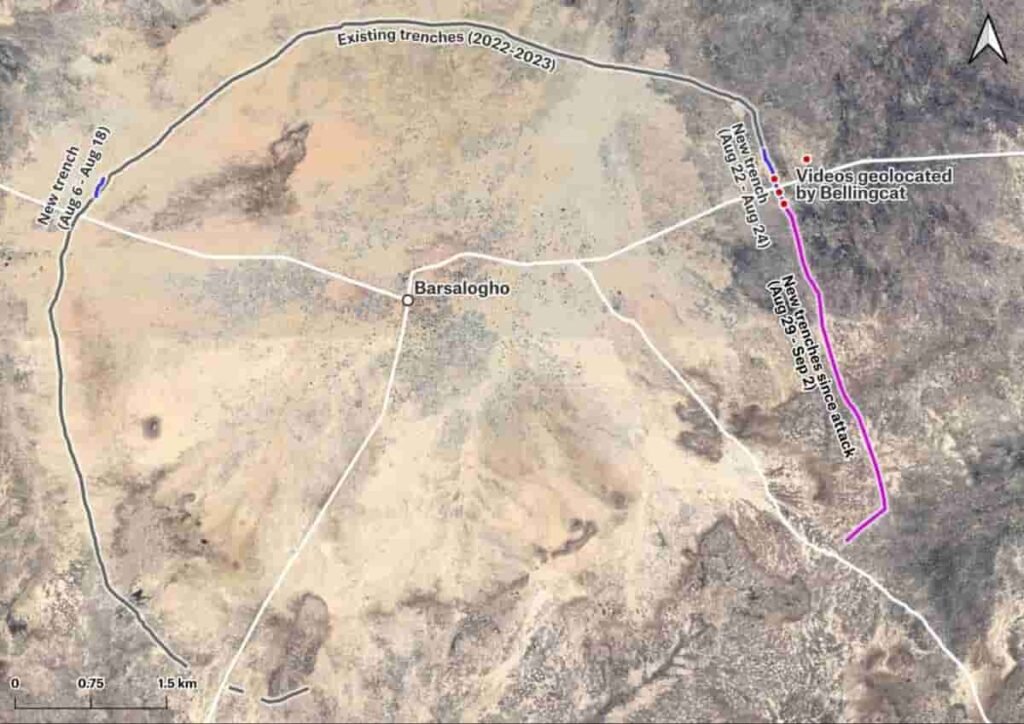The Barsalogho massacre represents one of the most horrific events in recent Burkinabè history. This tragic incident, which occurred on August 24, 2024, resulted in the death of over 100 unarmed civilians. The massacre highlights not only the brutality of the attack but also the complex dynamics of conflict in Burkina Faso.
Local residents, forced to dig defensive trenches for protection, became victims of a violent assault led by the Al-Qaeda-affiliated group JNIM. This article delves into the various facets of the Barsalogho massacre: how it unfolded, the victims involved, and the ramifications for the local community and international response.
What happened during the Barsalogho massacre?
The Barsalogho massacre was a brutal and calculated act of violence. On the fateful day, residents were coerced into creating defensive trenches, ostensibly to protect themselves from attacks. However, shortly after completing their labor, they were ambushed.
The assault was marked by extreme violence and cruelty. Survivors reported that the attackers used execution-style killings, leaving no room for escape or resistance. Eyewitness accounts suggest that the brutality was not just random violence; it appeared to be a targeted action against civilians caught in the crossfire of ongoing conflicts.
The aftermath of the massacre revealed a grim reality. Bodies were left unchecked, and the sight of the mass graves became a haunting reminder of the atrocities committed. The incident marked a significant escalation in the violence faced by civilians in the region, raising urgent questions about the protection of non-combatants in conflict zones.
Who were the victims of the Barsalogho massacre?
The victims of the Barsalogho massacre were primarily local residents, many of whom were families and children. This event highlights the tragic consequence of conflict, where innocent civilians bear the brunt of violence.
In the days following the massacre, community members gathered to mourn their loss. The emotional toll on the families affected is profound. Many of them lost loved ones in a matter of hours, leading to a deep sense of grief and trauma.
Additionally, the massacre has raised concerns about the broader implications for civilians living in Burkina Faso. The ongoing violence has resulted in a humanitarian crisis, with many people displaced from their homes and communities fractured by fear and insecurity.
How did the JNIM group conduct the attack?
The attack by JNIM was meticulously planned and executed. As an Al-Qaeda-affiliated group, JNIM has been known for its ruthless tactics, often targeting vulnerable communities. The assault on Barsalogho was no exception.
Reports indicate that the group coordinated their actions effectively, exploiting the lack of military presence in the area. They utilized the element of surprise, capitalizing on the residents’ false sense of security after digging trenches for protection.
Moreover, JNIM’s strategy involved psychological warfare. By attacking civilians in such a brutal manner, they aimed to instill fear and destabilize the region further. This method not only served their immediate goals but also contributed to a long-term sense of insecurity among the population.
What role did the Burkinabè army play in the incident?
The Burkinabè army’s role during the Barsalogho massacre raises serious questions about military responsibility and effectiveness. Despite being present in some capacity, the army failed to prevent the attack, leading to accusations of negligence.
Many locals have expressed frustration at the military’s inaction, claiming that they were not adequately protected. The residents believed they were safe after being forced to dig trenches, only to find themselves vulnerable just hours later. This crucial failure has led to a significant erosion of trust between the community and military forces.
Additionally, some reports suggest that the military may have been overwhelmed or poorly equipped to deal with the rising insurgency in the region. This raises broader concerns about military capabilities and the need for reform to effectively respond to threats against civilians.
What evidence exists regarding the attack?
Evidence of the Barsalogho massacre has surfaced through various mediums, including eyewitness testimonies and satellite imagery. Investigative efforts by organizations like Bellingcat have highlighted discrepancies in casualty reports and painted a clearer picture of the events as they unfolded.
Videos taken by locals during and after the massacre showed the horrific scenes of violence, including bodies lying unburied. These visual records serve as stark reminders of the level of brutality inflicted upon innocent civilians and have helped to document the incident for international scrutiny.
Moreover, satellite imagery has provided additional insights into the scale of the violence. Analysis of these images has corroborated reports of mass graves, further emphasizing the need for accountability and justice for the victims.
What is the current situation in Burkina Faso after the massacre?
Since the Barsalogho massacre, the situation in Burkina Faso has remained tense and precarious. The humanitarian crisis has deepened, with rising numbers of internally displaced persons seeking refuge from violence. Many communities are struggling to cope with the aftermath of the attack.
Human rights violations have continued, exacerbated by the ongoing conflict involving various armed groups. Civilians are increasingly caught in the crossfire, raising alarms about the need for protective measures and humanitarian assistance.
The government’s response to the massacre has also been lackluster. No official statement was released following the incident, which has left many feeling abandoned and unsupported. This silence from authorities has contributed to a growing sentiment of hopelessness among the population.
How can the international community respond to such atrocities?
The international community has a crucial role in addressing the atrocities witnessed during the Barsalogho massacre. There are several measures that can be taken to prevent future incidents and provide support to affected regions.
Firstly, increasing awareness about the human rights situation in Burkina Faso is essential. Global conflict awareness can motivate international organizations to intervene and provide humanitarian aid. This includes addressing the urgent needs of displaced populations and ensuring that civilians are protected from further violence.
Secondly, diplomatic pressure on the Burkinabè government can facilitate much-needed reforms within the military. Support for training and equipment for local forces should be prioritized so that they can effectively respond to threats against civilians.
Lastly, the international community must emphasize accountability for the perpetrators of such crimes. Investigations into the Barsalogho massacre and other similar incidents must be conducted transparently, ensuring that justice is served for victims and their families.
Questions related to the Barsalogho massacre
What were the circumstances leading to the Barsalogho massacre?
The circumstances surrounding the Barsalogho massacre were heavily influenced by ongoing instability in Burkina Faso. The increasing presence of extremist groups like JNIM has created a volatile environment where civilians are often caught in the middle.
Local residents were coerced into digging defensive trenches, believing this would offer them protection. Unfortunately, this false sense of security was shattered when JNIM launched their brutal attack. The lack of effective military presence in the area further compounded the situation, rendering civilians helpless against the onslaught.
Additionally, the broader socio-political context in Burkina Faso has contributed to the worsening humanitarian crisis. A combination of military failures and extremist violence has left civilians vulnerable, amplifying the risk of future atrocities.
How did JNIM justify their actions during the attack?
JNIM often justifies its violent actions through a narrative of resistance against perceived oppressors, framing itself as a defender of the local population against governmental forces. During the attack on Barsalogho, they claimed to be targeting military affiliates, though the reality showed a starkly different outcome—innocent civilians were the primary victims.
This justification is part of a broader strategy to gain support among disenfranchised communities. By framing their actions as a fight for liberation, JNIM seeks to legitimize their brutality, despite the overwhelming evidence of human rights violations.
Furthermore, the propaganda disseminated by groups like JNIM often exploits grievances within communities, creating a narrative that appeals to those who feel marginalized. This manipulation of local sentiments is a crucial element in their recruitment and operational strategies.
What measures can be taken to prevent future massacres in Burkina Faso?
Preventing future massacres in Burkina Faso requires a multifaceted approach. First and foremost, enhancing community safety and protection is vital. This can be achieved through better military training and equipment to ensure that the armed forces can effectively respond to threats.
Moreover, fostering dialogue within communities can help address grievances and build trust. Local engagement and empowerment are essential to mitigating the allure of extremist narratives that may arise from feelings of abandonment.
International support for humanitarian efforts is equally important. Providing aid to affected communities and ensuring access to basic needs can alleviate some of the pressures that contribute to violence. Collaborative efforts among governments, NGOs, and local leaders will be crucial in creating a more stable environment.
How is the local community coping after the attack?
The local community’s coping mechanisms following the Barsalogho massacre have been varied but challenging. Many are grappling with profound loss and trauma, leading to heightened anxiety and fear within the population.
Community gatherings have emerged as a way to mourn and support one another. These gatherings allow survivors to share their experiences, fostering a sense of solidarity amidst the grief. However, the emotional scars left by the massacre will take time to heal.
Additionally, many families have been displaced from their homes, further complicating their recovery. Access to resources, healthcare, and psychological support is crucial to help them navigate the aftermath of the violence. The resilience of the community is evident, but substantial external assistance is necessary to facilitate their healing process.




